January 31, 2012
A Thought Leader Series Piece
By Quentin Wheeler
Several centuries of species exploration have taught us that a vast number of Earth’s plants and animals are extremely limited in their ecological associations and geographic distributions. When these species lose their specific habitats, it usually means extinction. Yet, because we don’t know what or how many species actually exist or where they live, we are unable to detect or measure these quiet changes in biodiversity.
Each unknown loss, however, compromises our ability to understand the origin and history of life on our planet. More importantly, these losses seriously impede our ability to adapt to a rapidly changing environment on Earth.
Since Carl Linnaeus inaugurated the modern age of taxonomy in 1758, nearly two million kinds of plants, animals, and microbes have been discovered, described, named, and classified. This sounds like a lot, but an estimated 10 million species of “higher” organisms remain unknown to science, and the number of unknown microbial species could be even greater. Beyond that, to paraphrase former U.S. Defense Secretary Donald Rumsfeld, we don’t yet know what we don’t know about the living world around us.
Given all this, the hubris of writing laws and regulations to protect endangered species is laughable. How can we adapt agriculture to climate change or understand complex ecosystems while remaining ignorant of 90 percent of their functional parts? We have lived with this near-complete ignorance of species for so long that we fail to recognize that it need not be so.
What we need to do is invest in a mission to learn all species. We have this capability within our reach. Rather than settling for imprecise estimates of species diversity and untested ecosystem models, we must undertake a comprehensive inventory of every species on Earth. The benefits of completing such a taxonomic inventory would be immediate, profound, and enduring.
First, it would create baseline knowledge of the biosphere against which we could detect, monitor, and potentially respond to increases or decreases in biodiversity. The U.S. currently spends more than $130 billion per year mitigating the impacts of about 6,000 non-native species, but invests only a few million dollars in species exploration. With a more balanced approach, ecology could be empowered to explore the detailed interactions of organisms and detect invasive species before they become established, destructive, and costly.
Second, we would bequeath a legacy of biodiversity knowledge to future generations. Because there is little hope of manned space flights ever reaching a planet with more than a few microbes, our only hope for understanding organic evolution in depth is to gather, analyze, and preserve evidence of this history on Earth while we can. We will get no second chances.
Third, understanding biodiversity provides our best hope for finding ideas and inspiration to cope with environmental change. Natural selection has worked ceaselessly for 3.8 billion years to adapt species in sustainable ways to the challenges that humans face now. We need to open this vast library of sustainability options by exploring all the ways each species is unique. This effort would reveal the billions of ways in which other species successfully met climate and other challenges. The result could be the basis for a new kind of adaptive entrepreneurship based on time-proven strategies.
Now is the time. Advanced cyberinfrastructure has the potential to overcome every constraint that has held back rapid taxonomic advances in the past. No insurmountable scientific or technological barriers prevent a world species inventory, only political barriers. The enormous scale of the challenge will be dwarfed by the potential benefits to science and society.
Perhaps the greatest challenge will be to transform society’s outdated perception of taxonomy. ASU’s International Institute for Species Exploration is working to do that. The Institute is facilitating an international effort to accelerate species discovery, inspire the next generation of species explorers, create innovative tools that remove impediments to the growth of knowledge, and increase public awareness of the importance of natural history museums and the science of taxonomy.
About the author: Quentin Wheeler is a Senior Sustainability Scientist in the Global Institute of Sustainability, Virginia M. Ullman Professor of Natural History and the Environment in the School of Life Sciences and School of Sustainability, and founding director of the International Institute for Species Exploration at ASU at ASU. From 2007-2011 he was dean of the College of Liberal Arts and Sciences and university vice president. Before joining ASU in 2006, he was a professor of taxonomy at Cornell University, director of the division of environmental biology at the National Science Foundation, and keeper and head of entomology at London’s Natural History Museum. He writes a weekly feature on new species for The Observer in London, has named more than 100 new species, and has published and lectured extensively on the role of taxonomy in biodiversity exploration and conservation. He is author of the annual State of Observed Species report, which tracks newly discovered species around the world.


